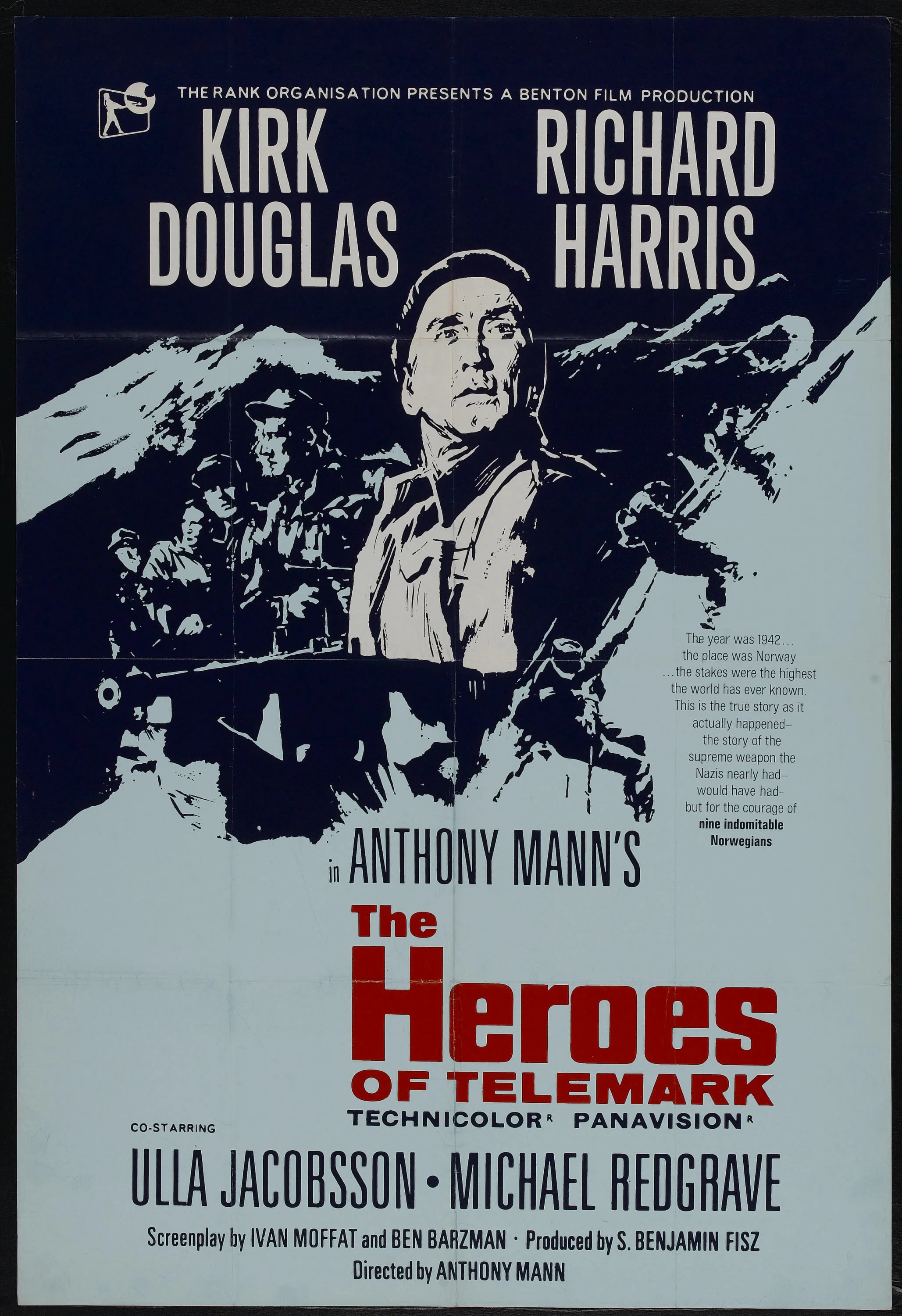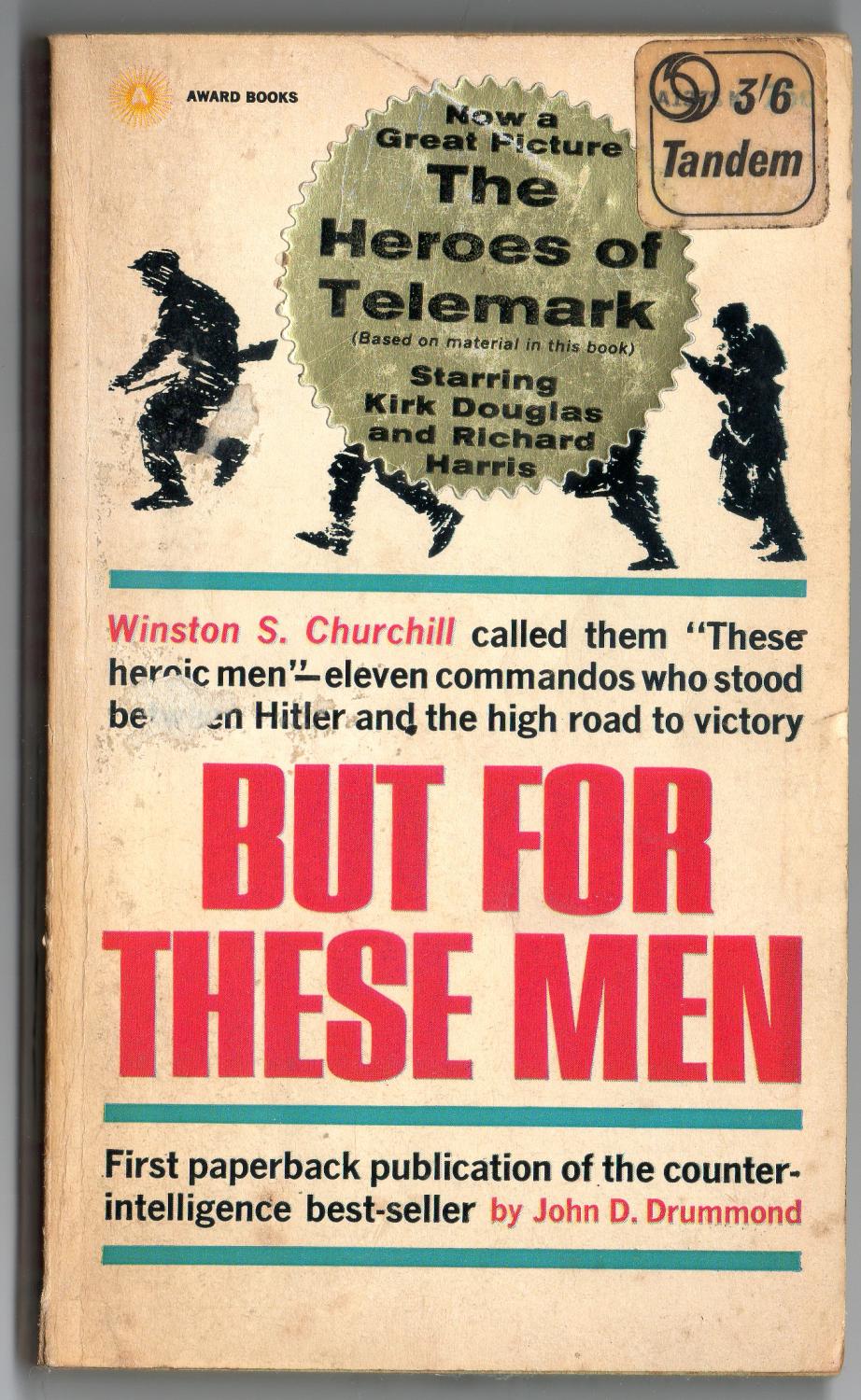
The Heroes of
Telemark is a Hollywood movie from 1965 that was released on DVD in 2008.
While the movie is based on a true story, historical truth is violated many times. Much of
what we see in this film is a product of the director’s vivid imagination. Here
are some basic facts about it:
** Directed by
Anthony Mann (1906-1967)
** Written by Ivan
Moffat and Ben Barzman
** Run time: 125
minutes
The cast includes
Kirk Douglas, Richard Harris, and Ulla Jacobsen. The screenplay is based on two
books: Skis against the Atom by Knut Haukelid (1954, 1989) and But for These
Men by John Drummond (1962, 1965).
The story takes place
during World War Two when German scientists were trying to develop atomic power. In
order to do this, they needed heavy water, which was produced at a factory at
Vemork in German-occupied Norway. The title of the film refers to a small group
of Norwegian resistance fighters, who carried out an attack on the heavy water
factory in February 1943 and an attack on the ferry that was transporting
barrels of heavy water across Lake Tinn in February 1944.
These acts of
sabotage crushed the German government’s hope of developing atomic power. Today
they are regarded as some of the most important acts of sabotage that were
carried out during the war.
The Heroes of
Telemark is dramatic and gripping from the beginning to the end. If you look
at it as just another action movie, you may like it and give it high marks. But
if you remember that it is based on a true story, I think you will be more
critical, because the director plays fast and loose with the historical facts.
There are many
problems with this film:
# 1. The first
problem is the question of language. The film is dedicated to the Norwegian
people because of their brave resistance against the German occupation, but
where are the Norwegians?
The two leading
male characters are from the US, while the leading female character is from
Sweden, and they all speak English! The Norwegians speak English to each other;
the Germans speak English with each other, usually with a heavy German accent
to remind us about their nationality.
There are a few
cases where a German officer gives an order in German, but once the order is
given, he will switch back to English. The decision to have all actors speak
English is most unfortunate, because the historical credibility of the film is
reduced to zero. This is not realistic.
# 2. The second
problem is the question of age. Kirk Douglas was born in 1916. In 1965 he was
49. He is much too old for this role. Richard Harris was born in 1930. In 1965
he was 35. While he is younger than Douglas, he is still too old for this role.
The members of the Norwegian group who carried out these attacks were young men
in their twenties.
# 3. The third
problem concerns the leading characters. Richard Harris plays a character who
is loosely based on Knut Haukelid, who was a member of the resistance group,
and author of one of the two books which inspired the film. Haukelid (who was born in 1911) was 32 in 1943. Harris was 35 when he played the role. This is acceptable. Things are different when we look at the other leading character.
Kirk Douglas plays a professor from the University of Oslo. No professor from Oslo was a member of the resistance group. Douglas is supposed to be a hero, but it is difficult to like him, because he is not a very sympathetic person (when you watch the film, you will understand what I mean when I say this).
Kirk Douglas plays a professor from the University of Oslo. No professor from Oslo was a member of the resistance group. Douglas is supposed to be a hero, but it is difficult to like him, because he is not a very sympathetic person (when you watch the film, you will understand what I mean when I say this).
# 4. The fourth problem concerns historical
truth which is violated several times. Here are a few examples:
(a) When the
saboteurs leave the factory after the attack, one of them is shot and killed by
the Germans. This is not true. One amazing fact is that all members of the
Norwegian group survived not only the attacks but also the war
(b) The German forces pursuing the saboteurs on skis are assisted by a Norwegian traitor. This is not true. No Norwegian traitor was involved here
(c) Having placed two bombs on the ferry that will transport barrels of heavy water across a lake, Kirk Douglas decides at the last minute to board the ferry. This detail is not true. No saboteur was on the ferry when the bombs exploded.
For reasons of space I will not mention more examples.
(b) The German forces pursuing the saboteurs on skis are assisted by a Norwegian traitor. This is not true. No Norwegian traitor was involved here
(c) Having placed two bombs on the ferry that will transport barrels of heavy water across a lake, Kirk Douglas decides at the last minute to board the ferry. This detail is not true. No saboteur was on the ferry when the bombs exploded.
For reasons of space I will not mention more examples.
I do not
understand why so many Hollywood directors feel they have to “improve” the true
facts when they direct a movie that is based on a true story. The true story is
already dramatic. There is no need to exaggerate or invent something that never
happened. The true story is so dramatic that it is hard to believe. Why not stick to the facts? They are dramatic
and they have the advantage that they are true.
While historical truth is violated several times,
there is one significant aspect of the film which is true: it was shot on the
right location. When we see the heavy water factory, it is the real factory (Norsk
Hydro) in Vemork. When we see the resistance fighters skiing, they are skiing
in the mountains near Vemork. When we see the ferry sailing on the lake, it is
sailing on Lake Tinn, the real lake.
CONCLUSION
As stated above,
The Heroes of Telemark can be regarded as just another action movie. If you
take this approach, you will probably like it, because it is a fascinating
story.
Unfortunately, I cannot
take this approach, because I cannot forget that historical truth is violated
many times. When I consider this element, I end up with a rather critical view
of the film.
It is a
fascinating story, which deserves to be told, but this film plays fast and
loose with the historical facts. Therefore I think it deserves a rating of
three stars.
PS # 1. In 1948,
a French-Norwegian film about the case
was produced. Translated into English, the title of this film is The Battle
for Heavy Water. One interesting fact about this film is that many of the
roles are played by Norwegian saboteurs, who play themselves. As far as I know,
this old film has never been released on DVD. It is available on YouTube.
PS # 2. In 2003,
BBC aired a three-part documentary film about the case that was produced and
narrated by Ray Mears. The title is The Real Heroes of Telemark. With a small
group of experts, Mears re-enacted many parts of the operation that the
saboteurs carried out during the war. According to Mears, the survival skills
of the Norwegian saboteurs are an important aspect of the story. Mears has also
written a book about the case, which has the same title as the film: The Real
Heroes of Telemark (2003, 2004).
PS # 3. In 2015, a
six-part drama produced by Norwegian television was aired. The title is The
Heavy Water War. In the UK, the miniseries is known as The Saboteurs. In
this version several languages are spoken, which makes it more realistic than
the Hollywood movie from 1965. However, one flaw is found in both of them: the
Hollywood movie introduces a fictional female character played by Ulla Jacobsen
(1929-1982). The Norwegian miniseries does exactly the same when it introduces
a fictional female character played by Anna Friel.
PS # 4. For more
information, see Heavy Water and the Wartime Race for
Nuclear Energy by Per F. Dahl (1999).
PS # 5. Hitler’s
Sunken Secret is a documentary film about the sabotage of
the ferry that was used by the German Army to transport barrels of heavy water
across Lake Tinn in 1944. It is an episode in the long-running program NOVA
which is devoted to the history of science (season 33, episode 5, first aired
on US television - PBS - in November 2005).
PS # 6. The
following articles about the Norwegian saboteur Joachim Rønneberg (born 1919) are
available online:
** Gordon Corera,
“Last hero of Telemark: The man who helped stop Hitler’s A-bomb,” BBC News, 25
April 2013
** Andrew Higgins,
“WWII Hero Credits Luck and Chance in Foiling Hitler’s Nuclear Ambitions,” New
York Times, 20 November 2015
***
A poster from the 1965 film with Kirk Douglas in the foreground.
***
The cover of Knut Haukelid's book from 1954.
The book was reprinted in 1989.
***
The book was reprinted in 1989.
***

The cover of John Drummond's book from 1965.
***
***
Excelente aporte. Muchas gracias
ReplyDelete